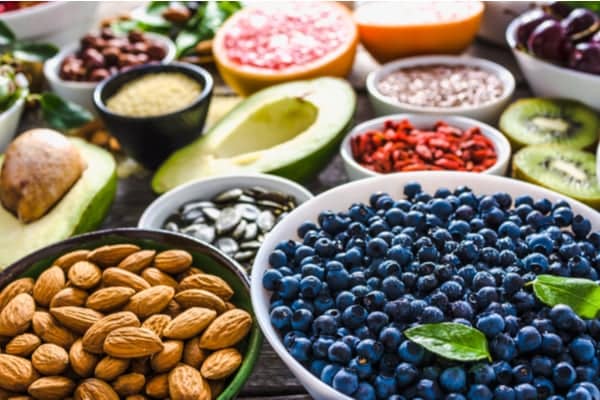The stage right after having a baby, called the postpartum period, can be a time of emotion, confusion, excitement, and change for new mothers.
Whether you are a prenatal/postnatal nutrition, health, and fitness coach or you have a client who recently had a baby, it is important to create a safe space for women who are doing their best to meet their needs and the needs of their new baby while juggling other responsibilities, like caring for older children and working.
This article describes the guidelines for a balanced postpartum diet and provides nine easy-to-prepare foods that help meet new mothers’ nutrient needs.

FREE TRIAL
Experience the AFPA Pre & Postnatal Fitness Specialist Course Firsthand for Free!
Experience 2 full modules from the AFPA Pre & Postnatal Fitness Specialist Certification Course for 14 days. No credit card required!
The Basics of a Balanced Postpartum Diet
Here, the word “diet” doesn’t refer to a restrictive, can and can’t list of foods to eat. A diet, in this context, just refers to an eating pattern.
In fact, food restriction of any type could be detrimental to the health of women in the postpartum stage and their children. After giving birth, their bodies are healing from the physical trauma of the birth experience and experiencing hormone adjustments, and they may be breastfeeding, which requires additional energy and nutrients.
Keep in mind that Western societies often pressure women to “lose the baby weight” in the months after giving birth. The pressure is not only emotionally detrimental to many women but can also cause them to severely restrict their nutritional intake.
Not getting enough nutrients from a variety of food can lead to:
- Malnutrition
- Poor milk supply
- Low energy
- Irritability
- Difficulty sleeping or staying awake
Additionally, poor nutrition may aggravate postpartum depression. With that being said, in general, a good approach to supporting women in the postpartum stage is to make sure they are getting enough of what they need, rather than focusing on food restriction.
Postpartum Nutrition and Dietary Guidelines
Below is a summary of the CDC and World Health Organization guidelines for the postpartum mother.
- Dietary recommendations in the postpartum period for mothers who are breastfeeding are very similar to the recommendations for pregnant women, with the exception that calorie and nutrient requirements increase slightly, so their food intake must reflect that. If mothers choose not to breastfeed, they should continue to eat a variety of foods that satisfy them and meet their individual needs but generally, they require less energy (calories).
- Mothers who choose to breastfeed require more calories. It is estimated that mothers who exclusively breastfeed need an additional 450-500 calories daily. These additional calories should come from nutrient-rich sources of food, like those we mention below.
- Postpartum mothers may need to take a multivitamin. It is possible to get all the nutrients they need through diet, but those who have trouble eating enough, struggle with food aversions, or follow diets that restrict or eliminate food groups may benefit from a multivitamin.
- Generally, postpartum mothers do not need to eliminate or avoid any foods. The exception is when women are averse to specific foods, experience allergies or food sensitivities, or notice changes in their breastfeeding babies after eating certain foods.
Specific Dietary Recommendations (MyPlate)
Postpartum women should generally follow the same healthy eating guidelines for the general population. However, they need to make sure they are eating enough to meet energy (calorie) needs. A breastfeeding woman who requires 2,800 calories daily should aim to eat the following:
2 ½ cups of fruit
- 1 cup from the Fruit Group counts as:
- 1 cup raw, frozen, or cooked/canned fruit; or
- ½ cup dried fruit; or
- 1 cup 100% fruit juice
3 ½ cups of vegetables
- 1 cup from the Vegetable Group counts as:
- 1 cup raw or cooked/canned vegetables; or
- 2 cups leafy salad greens; or
- 1 cup 100% vegetable juice
10 ounces of grains
- 1 ounce from the Grains Group counts as:
- 1 slice bread; or
- 1 ounce ready-to-eat cereal; or
- ½ cup cooked rice, pasta, or cereal
7 ounces of protein
- 1 ounce from the Protein Foods Group counts as:
- 1 ounce seafood, lean meat, or poultry; or
- 1 egg; or
- 1 Tbsp peanut butter; or
- ¼ cup cooked beans, peas, or lentils
3 cups of dairy or fortified soy milk products
- 1 cup from the Dairy Group counts as:
- 1 cup dairy milk or yogurt; or
- 1 cup lactose-free dairy milk or yogurt; or
- 1 cup fortified soy milk or yogurt; or
- 1½ ounces hard cheese
Sweets, cookies, and cakes can be consumed and enjoyed without a problem. The postpartum mother, however, should aim to get the majority of their nutrition from the above groups.
One important nutritional recommendation that often gets left out: Don’t forget to hydrate! Drinking plenty of water is essential for sleep, hormone regulation, and milk production.
Remember, these are just guidelines. Be kind to your clients, and support them in doing what is realistic for them in terms of their nutrition.
Navigating Beliefs Around Food Restriction and Excess in the Postpartum Stage
Beliefs around postpartum food restriction and excess in the months following birth have existed for thousands of years in countless ways across cultures. Some of these beliefs may be rooted in:
- Culture
- Religion and spirituality
- Anecdotes
- Family or community tradition
- Societal values
- Scientific research
There are countless beliefs around food restriction and excess in the postpartum stage. The nutrition coach has two primary roles when it comes to helping a client navigate these beliefs.
- Understand what those beliefs are, where they are coming from, and whether the person in the postpartum stage identifies with or feels harmed by those beliefs.
- Have the knowledge in nutrition science to offer information if your client permits it.
Note that beliefs aren’t inherently harmful and may even promote physical and mental health in postpartum women. Remember that beliefs, regardless of the type, are usually stemmed from a desire to support women’s health in the postpartum stage. For example, some cultures promote the consumption of clear broths or thick, maize-based drinks in the weeks after giving birth to help support the transition of pregnant bodies into postpartum bodies. These can be celebrated and enjoyed and fit perfectly into an eating pattern that supports women’s healing and nutrition.
If your client’s physician has identified certain eating behaviors based on beliefs that are detrimental to their health and that of their babies, learn about the beliefs to understand what they are stemmed in, why they are kept up, and how following them makes your client feel.
You can use principles of motivational interviewing and trauma-informed strategies to offer information about wellness needs, including nutrition, in the months after birth.
Ultimately, however, your client can choose whether or not to change behaviors stemmed from different belief systems. Roll with resistance, rather than confronting or opposing it, and recognize that your client may not feel like they have agency in modifying health behaviors.
9 Delicious (and Easy) Foods for the Postpartum Mother
The postpartum mother is just easing into the role of first-time mother or mother of an additional child. She is often short of time and sleep-deprived, and the data shows most postpartum mothers do not have support at home shortly after giving birth. This means that she is responsible for taking care of the newborn, her other children, and herself.
Here, we suggest nine foods that are easy to prepare and versatile, don’t require a lot of ingredients, are nutrient-dense, and that older child can enjoy as well.
Hard-Boiled Egg on Toast
This complete snack delivers carbohydrates, proteins, and fats that provide satisfaction and nutrition.
Eggs are complete proteins and also provide a combination of saturated and unsaturated fat. Whole wheat toast delivers much-needed energy, as well as fiber to help regulate your digestion after having a baby.
You can hard boil eggs ahead of time and keep them in the fridge. Slice up the egg, butter up whole wheat toast (or drizzle it with olive oil), and lay on the egg slices. Sprinkle with salt and pepper, and you have a satisfying snack in five minutes or less.
Baked Avocado with Egg
This baked egg on avocado requires a bit more time from prep to plate, but it only requires three ingredients and three steps to prepare.
Preheat the oven to 350°F, and cut an avocado in half. Remove the pit and a bit of the avocado around the pit to create a bigger hole. Crack in an egg on each side of the avocado, and cover with a slice of your favorite cheese. Place on a baking sheet and bake for 15 minutes.
If you find that the avocado rolls over, place it on a muffin tin.
The egg is a complete source of protein and provides satisfying fat. At the same time, it delivers a variety of vitamins and minerals. The avocado, in addition to having several antioxidant components, is also an excellent source of omega-3 fatty acids and fiber.
Instant Oatmeal
Oatmeal is a delicious and easy stick-to-your-ribs meal. Choose the brand of oatmeal you like best and in a few minutes, you’ll have a satisfying and hot meal or snack. If you like, and you have it on hand, you can add seeds, berries, chocolate chips, banana, or nuts to your oatmeal.
Need something to keep the older kids occupied for a few minutes? Set out a variety of oatmeal “toppings” and let them have their fill.
Oatmeal is a great source of complex carbohydrates and fiber, is rich in antioxidants, and helps to regulate blood sugar. Best of all, it is a filling meal that is appropriate for kids and adults alike.
Nut Butter on Celery
Celery is a vegetable that requires minimal prep time, but it is also rich in vitamins, minerals, and antioxidants. Slice up a few stalks of celery into bite-size pieces and serve a few tablespoons of your favorite nut butter on the side.
Nut butter is nutrient-dense and calorie-dense. Many new breastfeeding mothers have trouble consuming enough calories, and nut butter is a great way to add minerals and fats to the diet.
Make it fun for the kids! Top the celery and peanut butter with raisins, and you have ants on a log.
Smoothies Galore
Whatever fruits and leafy veggies you have in the fridge can be the base of a delicious smoothie. Not only are smoothies an easy way to satisfy your fruit and vegetable craving, but they also help you stay hydrated.
There are endless ways to make a delicious and nutritious smoothie. Here are some ingredient ideas to get you thinking:
- Blueberries, banana, and the milk of your choice
- Banana, strawberry, peanut butter, and the milk of your choice
- Apple, spinach, celery, pineapple, and water
- Banana, flavored protein powder, yogurt, and the milk of your choice
- Melon, pineapple, mango, and water or juice
- Cocoa powder, banana, strawberry, vanilla extract, cinnamon, and the milk of your choice
You can make a big smoothie batch and freeze whatever you don’t drink in an ice cube tray for an even faster prep time later on.
Veggie Plate and Hummus
One of the things that deter people from eating vegetables is that the thought of peeling, seasoning, and cooking them can seem daunting and time-consuming. Most new mothers do not want to prepare foods that add stress or require a lot of time.
You can purchase a pre-made veggie plate at the store, or, if you find the time, you can choose a variety of raw veggies to serve with pre-packaged hummus.
Vegetables are an important part of the human diet because, together with fruits, they deliver fiber, antioxidants, vitamins, and minerals more efficiently than any other food group.
If you are thinking of making your own veggie plate, we suggest choosing vegetables that can be served raw and require minimal prep, such as cherry tomatoes, broccoli, celery sticks, snap peas, baby carrots, and bell pepper slices.
Overnight Chia Pudding
Overnight chia pudding is a great breakfast idea for those busy, early mornings.
Not only is chia pudding fun to eat with endless topping possibilities, it is a great source of omega-3 fatty acids. Plant-based omega-3 fatty acids have several benefits for moms, from improved heart health to decreased inflammation and better brain function.
Overnight chia pudding is easy to make: In a bowl or mason jar, add two tablespoons of chia to 1 ½ cups of the dairy or plant-based milk of your choice. Mix in the toppings of your choice, and place it in the fridge overnight.
Trail Mix
No muss, no fuss. Pre-made trail mix is an excellent instant snack that is packed with vitamins and minerals.
If you like trail mix, we suggest always having a bag of your favorite kind around the house for those days when you feel hungry and your baby doesn’t want to be put down.
Yogurt and Goodies
This is a simple go-to, anytime-of-the-day meal. Take your favorite yogurt and top it with whatever “goodies” you have around the house.
Here are some ideas:
- Fruit (frozen, dried, or fresh)
- Dried coconut
- Sliced almonds
- Chia seeds
- Cereal
- Chocolate chips
- Peanut butter
- Honey
- Granola
Need more ideas? Check out these articles:
- 14 Heart-Healthy Foods (Plus 4 Quick and Easy Plant-Based Recipes)
- 10 Best Plant-Based Healthy Snack Ideas For 2021 (Easy & Delicious!)
- How to Make Healthy Food Delicious
Main Takeaways
New mothers have many unmet needs in the months after giving birth. As a holistic nutrition or health coach to a postpartum mother, you can provide support to them by applying wellness principles, creating a safe space for them to express themselves, managing unrealistic postpartum body ideals, and offering information on how they can meet their nutrition needs, which often go overlooked.

Get Your Free Guide
Learn How to Start a Fulfilling, Impactful Career as a Holistic Health Coach
You’ll learn:
- Why holistic health matters
- If holistic health coaching is right for you
- What career opportunities exist for health coaches
- And more!



